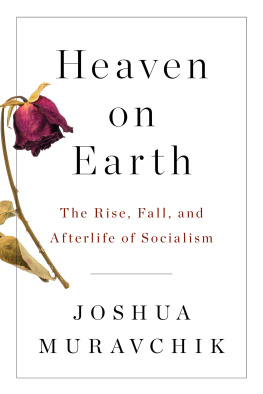

| Heaven on Earth The Rise, Fall, and Afterlife of Socialism 
JOSHUA MURAVCHIK New York London |
2002, 2003, 2019 by Joshua Muravchik
All rights reserved. No part of this publication may be reproduced, stored in a retrieval system, or transmitted, in any form or by any means, electronic, mechanical, photocopying, recording, or otherwise, without the prior written permission of Encounter Books, 900 Broadway, Suite 601,
New York, New York 10003.
First American edition published in 2002 by Encounter Books, an activity of Encounter for Culture and Education, Inc., a nonprofit, tax exempt corporation.
Encounter Books website address: www.encounterbooks.com
Manufactured in the United States and printed on acid-free paper. The paper used in this publication meets the minimum requirements of ANSI/NISO Z39.48-1992 (R 1997) (Permanence of Paper).
First paperback edition published in 2003.
Second paperback edition published in 2019.
Paperback edition ISBN: 978-1-59403-963-8
THE LIBRARY OF CONGRESS HAS CATALOGUED THE HARDCOVER EDITION AS FOLLOWS:
Muravchik, Joshua.
Heaven on earth : the rise and fall of socialism / Joshua Muravchik. p. cm.
Includes bibliographical references and index.
ISBN 1-893554-45-7 (alk. paper)
SocialismHistory. I. Title.
HX36.M87 2002
335.009dc21
2001055681
To Sally
The Christian imagines the better future of the human species in the image of heavenly joy. We, on the other hand, will have this heaven on earth.
Moses Hess, A Communist Confession of Faith, 1846
CONTENTS
Franois-Nol Gracchus Babeuf, the first socialist.
Robert Owen came to the New World to organize a practical demonstration of the superiority of the social system. (Photograph by the Indiana Historical Society of John Cranchs 1845 portrait.)
The Manchester (England) Hall of Science where Owens followers held Sunday services, attended frequently in 1843 by the young Friedrich Engels. (Courtesy of the Central Library of Manchester.)
Friedrich Engels and Karl Marx, the high priest and oracle of the new religion of Scientific Socialism, with Marxs daughters, Laura, Eleanor and Jenny, in London in 1864. (Courtesy of the Friedrich Ebert Foundation, Trier.)
Eduard Bernstein, the leading disciple of Marx and Engels, worried that their forecasts were not coming true. (Courtesy of the Friedrich Ebert Foundation, Bonn.)
Lenin haranguing a crowd in Moscow in 1920. Trotsky, standing at his lower right, was later famously airbrushed out of the photo by Stalin. (Courtesy of the David King Collection.)
Il Duce, Benito Mussolini, exhorting Italians to win the battle for grain. The outbreak of world war in 1914 convinced him that nation could be a more potent revolutionary principle than class. (From Rizzoli Photo Archives.)
Prime Minister Clement Attlee was a perfect British gentleman, conservative about everything except socialism. (Courtesy of the German Historical Museum, Berlin.)
President Julius Nyerere with Chinese economic advisers laying the cornerstone of the Friendship Textile Mill, a symbol of Tanzanias socialist road to development. (From the Warder Collection.)
Alexandr Solzhenitsyn thanks George Meany on behalf of all the prisoners of the Soviet gulag for the AFL-CIOs militant defense of human rights against communism. (Courtesy of the George Meany Labor Studies Center.)
Samuel Gompers abandoned socialism for bread-and-butter unionism. This photo was shot by a detective keeping his eye on a labor organizing campaign. (Courtesy of the George Meany Labor Studies Center.)
Deng Xiaoping at a Texas rodeo during his 1979 visit to the United States, the first by a leader of the Peoples Republic of China. His opening to the West was a cornerstone of economic reforms that undid socialism.
Aspiring rock star Tony Blair at Oxford. By jettisoning ideology, he got the Labour Party back in tune with British voters. (Courtesy of South West News Service, Bristol.)
Moses Hess, who helped introduce Marx and Engels to communism, proclaimed that the difference between Christians and Communists was that the Communists will have this heaven on earth. (Painting by Gustav Adolf Koettgen, 1845, by permission of the City Museum of Dsseldorf.)
Kibbutz Ginosar on the banks of the Sea of Galilee: initially some tents and huts surrounded by a stockade and watchtower, it was a verdant resort by the 1970s. (Courtesy of Ada Tsoref.)
Next page































